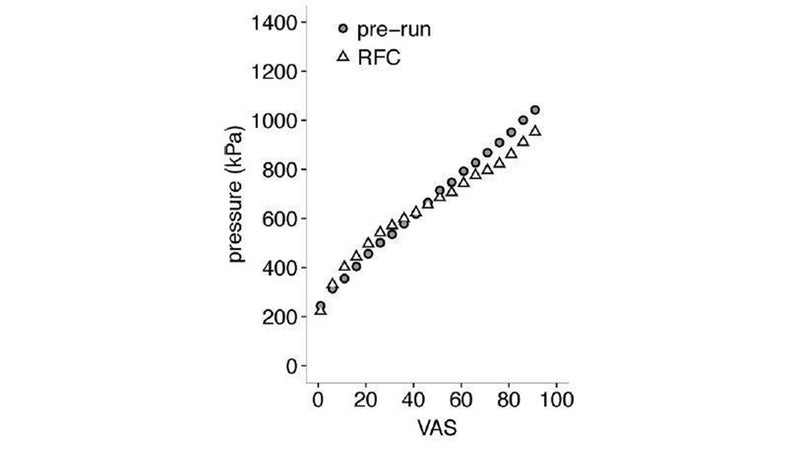The first step of any run is always the hardest. Not in a physical sense, given that I start even my hardest workouts at a geriatric shuffle, but in a psychological sense. Getting out the door requires overcoming the not-entirely-illogical feeling that not running would be infinitely more comfortable and pleasurable than running. And yet long-time runners manage to win this mental battle day after day. There are, of course, all sorts of factors that play into that decision for any given person at any given time. But one underappreciated element, according to a new study, may be that seasoned runners experience a taste of runner’s high before they even head out the door.
Researchers at Friedrich Schiller University in Germany asked 15 trained runners to do a two-hour long run preceded by a set of pain tests, some of which were performed in an fMRI brain scanner. For comparison, the runners also completed the same tests on another day when they weren’t planning to run. The results, in Behavioural Brain Research, suggest that the mere anticipation of going for a run elicits changes in how you feel and how the brain processes pain, and that these changes are more pronounced the more you run.
We’ve all heard the familiar story of how exercise generates endorphins, which in turn numb pain and in some people produce a euphoric runner’s high. As it turns out, the actual brain chemistry of exercise is quite a bit more complicated and less well understood. Sustained exercise triggers a wide range of neurochemical changes, not just related to endorphins (the body’s natural morphine equivalents) but also endocannabinoids (your pot equivalent) and various neurotransmitters like serotonin and GABA that may affect mood and mental state. A Penn State study on runner’s high found evidence that all three of those mechanisms likely play a role.
While relatively few runners experience the clichéd euphoric interludes often associated with runner’s high, lots of us feel better in some way after a good run. And if you experience that effect over and over again, you may eventually condition your brain to associate the prospect of running with its usual neurobiological response, independent of the action itself. This is called classical conditioning, and it can occur in all sorts of contexts: when you imagine your next meal, your stomach starts secreting gastric acids in anticipation; when the polar swimmer Lewis Pugh was preparing for plunges in icy waters, found that his core temperature would begin climbing before he jumped in. In this case, the German researcher team hypothesized that lacing up your running shoes may trigger some of the euphoria and altered pain processing normally triggered by running.
The pre-run tests included a psychological questionnaire, plus a pain test administered with an algometer, a machine that basically jabs a probe (like the blunt end of a pencil) into your lower leg with increasing pressure until you can’t stand it anymore while you rate the pain on a scale of 1 to 100. Then the subjects were loaded into the brain scanner and pricked repeatedly with pins to assess which parts of the brain lit up most angrily. The hypothesis: the runners would be more euphoric and better able to handle pain right before their-two hour run than on their off day.
The results, to be frank, were more muddled and ambiguous than you might hope (especially if you’re a science journalist trying to spin a simple story). There were no overall differences in euphoria or pain sensitivity. Here, for example, is what the pain ratings looked like (VAS stands for “visual analog scale,” which is the type of pain rating they used), as a function of the pressure applied with the blunt probe. RFC stand for “run-free control,” a fancy way of saying it was the day off.

If you look at the higher pressure levels—near 1,000 kPa, say—it does appear that the runners were consistently rating the resulting pain a bit lower on the pre-run day than the non-running day. But there was enough variability in the ratings that this difference didn’t turn out to be statistically significant.
In fact, it’s only when you start to dice up the results into subgroups, for example comparing the less trained runners (who averaged less than 25 miles a week) with the more highly trained runners in the group, that statistically significant differences start to emerge. In highly trained runners, it does take a significantly greater pressure to produce a given level of pain before a long run—but, contrary to the other part of the hypothesis, the highly trained runners are less euphoric pre-run. The brain scanning results are similarly ambiguous: brain activation in response to painful stimuli is definitely different before a run, but it’s not clear what those changes mean or how they affect different types of runner.
The reason this study grabbed my attention is that our expectations can have such a powerful effect, both for better and for worse. A few months ago, Ulster University psychologist Noel Brick published a (nicely explained by Scott Douglas) in which runners had to race a series of 3K time trials on a treadmill, sometimes with the last 800 meters up a steep incline. In one case, the runners were warned about the hill in advance, while in another case they encountered it as a nasty surprise. The result: those who knew about the hill pushed just as hard (as judged by perceived effort and heart rate) but ran more slowly for the first part of race, ending up with a worse overall result. Somehow their fear of the upcoming challenge made them run less efficiently. Knowledge was a curse.
It’s not immediately obvious how to connect those two studies. What Pavlovian neurochemical response does the fear of a big hill trigger, and how does it counterbalance the more positive associations we have with running? The German researchers acknowledge this complexity: the dulled pre-run pain response, they note, might have nothing to do with endorphins and instead be a simple result of distraction due to the upcoming challenge of the long run. Given the somewhat muddled results of the new study, I think it’s fair to say we have more questions than answers at this point. But the questions are very much worth asking, and the preliminary hints in the data are intriguing. They give me hope that one day, with enough practice, I’ll be able to get my runner’s high while lying on the sofa, just by thinking about the hypothetical run that I might do.
My new book, , with a foreword by Malcolm Gladwell, is now available. For more, join me on �����Ի���, and sign up for the Sweat Science .


